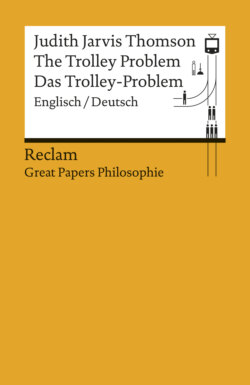Читать книгу The Trolley Problem / Das Trolley-Problem (Englisch/Deutsch) - Judith Jarvis Thomson - Страница 8
На сайте Литреса книга снята с продажи.
IV.
ОглавлениеIt should be clear, I think, that “kill” and “let die” are too blunt to be useful tools for the solving of this problem. We ought to be looking within killings and savings for the ways in which the agents would be carrying them out.
It would be no surprise, I think, if a Kantian idea occurred to us at this point. Kant said: “Act so that you treat humanity, whether in your own person or in that of another, [32]always as an end and never as a means only.” It is striking, after all, that the surgeon who proceeds in Transplant treats the young man he cuts up “as a means only”: He literally uses the young man’s body to save his five, and does so without the young man’s consent. And perhaps we may say that the agent in Bystander at the Switch does not use his victim to save his five, or (more generally) treat his victim as a means only, and that that is why he (unlike the surgeon) may proceed.
But what exactly is it to treat a person as a means only, or to use a person? And why exactly is it wrong to do this? These questions do not have obvious answers.6 [1402]
Suppose an agent is confronted with a choice between doing nothing, in which case five die, or engaging in a certain course of action, in which case the five live, but one dies. Then perhaps we can say: If the agent chooses to engage in the course of action, then he uses the one to save the five only if, had the one gone out of existence just before the agent started, the agent would have been unable to save the five. That is true of the surgeon in Transplant. He needs the young man if he is to save his five; if the young [34]man goes wholly out of existence just before the surgeon starts to operate, then the surgeon cannot save his five. By contrast, the agent in Bystander at the Switch does not need the one track workman on the right-hand track if he is to save his five; if the one track workman goes wholly out of existence before the bystander starts to turn the trolley, then the bystander can all the same save his five. So here anyway is a striking difference between the cases.
It does seem to me right to think that solving this problem requires attending to the means by which the agent would be saving his five if he proceeded. But I am inclined to think that this is an overly simple way of taking account of the agent’s means.
One reason for thinking so7 comes out as follows. You have been thinking of the tracks in Bystander at the Switch as not merely diverging, but continuing to diverge, as in the following picture: pick up figure 1
[36]Consider now what I shall call “the loop variant” on this case, in which the tracks do not continue to diverge – they circle back, as in the following picture:
[1403] Let us now imagine that the five on the straight track are thin, but thick enough so that although all five will be killed if the trolley goes straight, the bodies of the five will stop it, and it will therefore not reach the one. On the other hand, the one on the right-hand track is fat, so fat that his body will by itself stop the trolley, and the trolley will therefore not reach the five. May the agent turn the trolley? Some people feel more discomfort at the idea of turning the trolley in the loop variant than in the original Bystander at the Switch. But we cannot really suppose that the presence or absence of that extra bit of track makes a major moral difference as to what an agent may do in these cases, and it really does seem right to think (despite the discomfort) that the agent may proceed.
On the other hand, we should notice that the agent here needs the one (fat) track workman on the right-hand track [38]if he is to save his five. If the one goes wholly out of existence just before the agent starts to turn the trolley, then the agent cannot save his five8 – just as the surgeon in Transplant cannot save his five if the young man goes wholly out of existence just before the surgeon starts to operate.
Indeed, I should think that there is no plausible account of what is involved in, or what is necessary for, the application of the notions “treating a person as a means only,” or “using one to save five,” under which the surgeon would be doing this whereas the agent in this variant of Bystander at the Switch would not be. If that is right, then appeals to these notions cannot do the work being required of them here.
